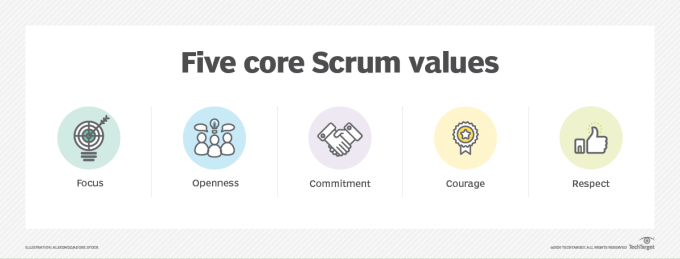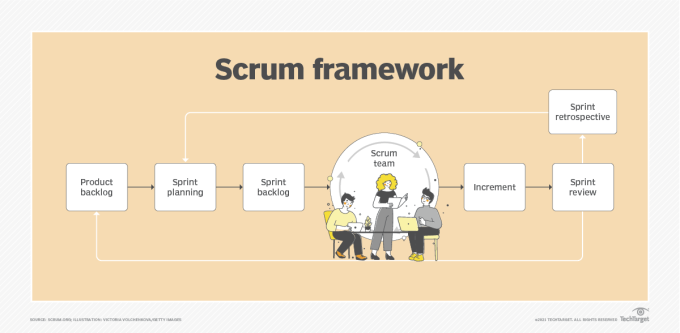Are there too many meetings in Scrum?
What’s the most common complaint I hear about Scrum? It’s that Scrum has too many meetings.
People who say that are wrong.
Four Scrum meetings types
There are only four types of Scrum meetings that occur within a development sprint:
- The sprint planning meeting.
- The sprint review.
- The sprint retrospective.
- The daily Scrum.
Every one of these Scrum meeting types is essential. It’s hard to imagine how anyone might justify removing any of them from the framework.
Scrum’s sprint planning meeting
Scrum asserts that before a team begins a two- three- or four-week development effort, they should spend a bit of time planning.
Teams are instructed not to spend a lot of time planning. A sprint planning meeting should never last more than eight hours, and a Scrum team should never plan for more than a month’s worth of work.
A single planning meeting every month to discuss some goals and put together a development plan hardly seems like an unreasonable imposition on a development team.
Scrum’s sprint review meeting
The Scrum guide also insists that a development team should meet regularly with the stakeholders that fund the development work.
The four-hour sprint review meeting happens at the end of each sprint. A sprint isn’t allowed to go longer than a calendar month, which means stakeholders never wait more than 30 days to inspect the team’s work.
A team of eight full-time developers collectively put in over 1200 hours of work in a month. A four-hour review meeting to discuss 1200 hours of progress is not an imposition — it’s due diligence.
Scrum’s sprint retrospective meeting
The final Scrum meeting that marks the end of sprint is the sprint retrospective. Time-boxed to a maximum of three hours, the sprint retrospective gives the developers a chance to talk about:
- What worked during the sprint?
- What went wrong during the sprint?
- What can they do better in future sprints?
To improve their processes and methods, teams must take time to reflect on how well they work together. A short meeting every month to discuss team dynamics and implement some changes that make the team more productive aren’t a waste of time.
The daily Scrum meeting
My guess is when people talk about Scrum having too many meetings, they’re probably talking about the daily Scrum.
If the daily Scrum feels like an waste of time, then you’re doing the daily Scrum wrong.
The daily Scrum is a quick, 15-minute chat where the developers on the team talk about what they’re doing.
The daily Scrum shouldn’t feel like a formal, highly structured meeting. The daily Scrum should feel casual and natural. It certainly shouldn’t feel like a status meeting.
Normal, natural communication
Did you ever work on a team project in high school or college? One where you all had to meet up in the library three or four times to get the project finished?
What was the first thing you all did for the first 15 minutes when you got together?
- You complained about your prof.
- You talked about what other teams were doing.
- You discussed what you managed to get done.
- You talked about what you didn’t get done.
- You asked others for help with things you couldn’t manage.
- You talked about things that were blocking your progress.
- You offered help to others if they had a problem.
You’d have a pretty dysfunctional team if people didn’t chat casually about these types of things when they all get together.
Minimal meeting formality
The Scrum framework simply insists that a quick discussion like this happens every workday between the developers. The Daily Scrum is really just a recognition of the natural behavioral patterns of highly motivated and enthusiastic development teams when they collaborate on a project.
The daily Scrum meeting does necessitate some formality, though:
- The daily Scrum meeting should take place at the same time every workday.
- The daily Scrum meeting should take place in the same location every day.
- During the daily Scrum developers talk about the project, not their vacation plans.
- The daily Scrum should never last for longer than 15 minutes.
In North America, it’s not unusual for a development team to burn through $250,000 of budget money each month.
Given such high stakes, it hardly seems like an unreasonable imposition to ask developers to meet each workday for 15 minutes to talk about how they can support each other.

Too many Scrum meetings would go against the five Scrum values.
Which Scrum meeting type would you remove?
When people say Scrum has too many meetings, I ask them which ones they think should be removed.
- Should there be no sprint planning meeting?
- Should sprint reviews with the stakeholders not meet regularly?
- Should teams not reflect on their practices each month?
- Should team members not meet for a few minutes each day to support each other?
Each different Scrum meeting type plays an important role to keep the development process transparent, while at the same time enables stakeholders to inspect progress and giving developers the chance to adapt when necessary.
Scrum doesn’t have too many meetings. Scrum gets it just about right.





